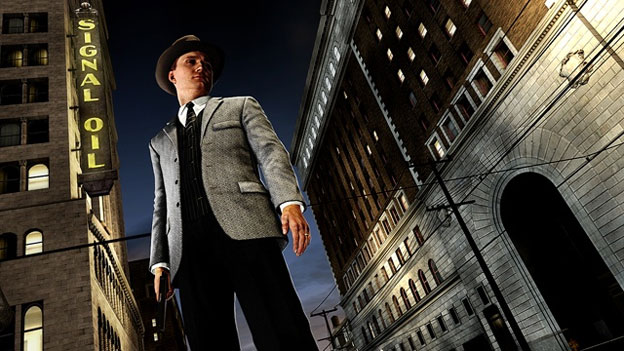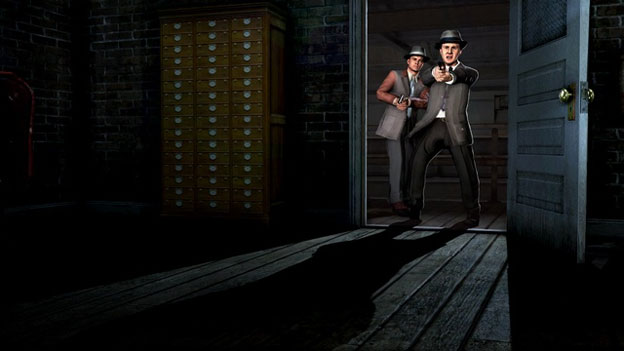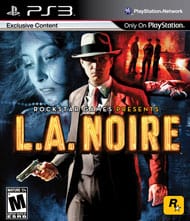Hollywood’s Golden Age Turns Blood Red
Between the Grand Theft Auto series and games like Bully, Rockstar isn’t exactly known for putting out games that place the player on the right side of the law. So, what made them decide to take on a police procedural game set in 1940’s Los Angeles? “We get pitches all the time for games, and it’s always like, ‘let’s do a shooter’ or ‘how about you guys do another open world game,'” stated our guide in Rockstar’s L.A. Noire booth at PAX East. “This is really different not only from what for Rockstar, and not only is the company excited about the challenge, it seems poised to knock this one out of the park.

Our preview allowed us to watch Rockstar’s representatives playing through a good portion of “The Red Lipstick Murder,” a homicide case, which, like all the cases in the game, is based on an actual case from the time period. The game is set in Los Angeles in 1947, a particularly violent year during the post-World War II era in Hollywood. Protagonist Cole Phelps is a war hero who has returned to civilian life and begins the game as a rookie beat cop. As he successfully solves cases and advances his career, he is promoted to different “desks” such as Burglary and Arson. Each desk has an overarching storyline, and the Homicide desk deals with a serial killer. Of course, Rockstar didn’t spoil the identity of the killer in “The Red Lipstick Murder,” but there was certainly speculation among the characters in the game that the mysterious serial killer could have been involved.
As the case began, we saw Phelps at the police station, being introduced to his new partner, as he’d just been promoted to the Homicide desk. Our guide mentioned that every desk includes a different partner, some of whom are more helpful than others. Partners in L.A. Noire can help the player in various ways. If they’re investigating something closely at a crime scene, it’s a hint that the object could be important. They can also be asked for advice or comment on a case, and will drive the squad car on request. This gives the player the choice to either explore the city by driving, or to get to a destination quickly by asking the partner character to drive. Phelps’s partner in Homicide was a grizzled veteran who appeared to be more interested in nursing drinks than solving cases, likely increasing the difficulty level of the Homicide desk.

Upon the partners’ arrival at the murder scene, one of the first noticeable things about the game was the extremely sparse user interface. Very few interface elements come between the player and the world, and simple button presses are used to investigate things of interest. Selecting an object (or in the case of The Red Lipstick Murder, a dead body) allows the player to manipulate it with the controller and search for clues. We watched as our guide used the controller to manipulate the murder victim’s limbs, turning them over in order to look for bruises or other evidence. Later, he solved a rotating globe puzzle by rotating pieces until the globe opened, revealing that the puzzle was a promotional cigarette lighter that contained the address of a new place of interest for the investigation. Other methods of investigation seen throughout the preview included using 1940’s-era detective skills such as rubbing a pencil over a pad of paper to read pen-marks and calling in a license plate number to be identified.
All relevant case notes are recorded in Phelps’s notebook, which doubles as the game’s menu interface, but gamers shouldn’t think that the automatic note-taking relieves them of the need to pay careful attention to what’s going on. Understanding and remembering the facts of the case will be vital when interrogating suspects, especially when trying to catch them in a lie. Suspect interrogation was the next major aspect of L.A. Noire that we were shown during our preview, as Phelps visited a cabana-themed bar frequented by the murder victim.

This segment introduced us to what is by far the most impressive thing about L.A. Noire: the motion capture system the team used in order to create characters whose facial expressions can be judged during police interrogations. The game’s characters telegraph their personalities with their postures and facial expressions in a way that’s unprecedented in the world of video games. If their expressions are sometimes a bit over-telegraphed during interrogations, it can probably be forgiven in a game that expects players to “read” suspects without the benefits of actual police training. That’s exactly what our guide proceeded to do with the suspects we saw. When telling the truth, suspects appeared confident and looked Phelps straight in the eye. When lying, they appeared more guarded and their eyes would dart to the side or refuse to focus straight on Phelps. At crucial points in the interrogation, the player was prompted to believe, doubt, or accuse the suspect of lying. For a straight up accusation, evidence needs to be produced, which is where the notebook comes in. Successfully reading the suspect and choosing correctly to believe or disbelieve will lead the player forward in the case, while choosing poorly can cause the player not to receive vital information from a suspect, requiring alternate methods of solving the case.
The motion capture system shines beyond its usefulness in interrogations, however. With the impressive detail allowed for facial expressions, the game’s characters finally do credit to their voice actors’ performances. When Phelps mentions that his new partner is “welcoming” him to the Homicide Department, the sarcasm is clear on his face. When a matronly neighbor expresses shock at the events happening next door, her face and gestures show not mere shock, but the kind of shock expressed by a woman with outraged middle-class morals. This kind of advanced characterization and subtlety of expression truly brings the game’s characters alive and adds a great deal of plausibility to the game’s world.
Although the characters themselves look impressive, the rest of the game’s graphics are no slouch, either. Rockstar has done its usual excellent job of realizing the look of a city in this game. The plants and buildings in the game are authentically Southern Californian, causing this native daughter of the state to feel right at home. At the same time, Rockstar has obviously gone to great lengths to depict the 1940’s, from the cars to the fashions to the rotary telephones. It looks like it will be a treat to simply drive around the city in the squad car, taking in the sights of one of America’s greatest cities from an earlier, albeit no less complicated, time.

Although L.A. Noire’s sound wasn’t always easy to hear thanks to the rather noisy convention in our background, the jazz-filled soundtrack seemed properly atmospheric and the voice actors all sounded solid. The most interesting part of the sound design that we saw, however, was the way sound effects were used in order to aid investigations. When Phelps is searching an area, a sound effect plays if there is an object nearby that can be investigated, preventing the game from becoming the 3D version of the old adventure game pixel hunts, although our guide was quick to point out that not every object will actually be useful to the investigation. Also, as long as there are items in an area to investigate, the “investigation music” plays. When the music stops, the player knows that they’ve seen everything they can. It’s a nice way to assist the player without adding visual interface elements or the usual sparkles or glows around interactable objects.
One aspect of the game that we didn’t see a great deal of was the action sequences. While L.A. Noire will be a slower-paced game than Rockstar’s usual offerings, it will include gunfights, fist fights, car chases, and other staples of the crime drama genre. We saw one fistfight during our preview, which occurred when a suspect became agitated as evidence against him was presented, and it looked like a fairly standard action sequence. It will be interesting to see how the larger action sequences play out, since while Phelps won’t be bound to today’s standards for police officers, he’ll presumably want to minimize damage to property and innocent bystanders.
Our preview ended partway through “The Red Lipstick Murder,” since Rockstar didn’t want to spoil the solution to the case for us. After the preview, we asked if it was possible to permanently mess up a case, causing a required reload or restart, and were told that there wouldn’t be a way to completely fail a case, because there will always be a workaround for players who miss vital evidence or botch an interrogation. The penalty for poor investigative work is that the player may not have a full picture of what happened in the case, but there won’t be any classic adventure game moments where the player can’t proceed with the game and doesn’t know why.
L.A. Noire is shaping up to be an impressive game, bringing cutting-edge technology, accessible gameplay, and a bit of action to the underused crime-solving game genre. It’s worth a look for the motion-capture technology alone, but many other aspects of the game look impressive as well. Rockstar has captured the look and feel of Los Angeles in the 1940s and is working to create a game that reaches a level of maturity beyond their previous offerings. If the story and overall gameplay can hold up to the snippets we have seen of the game so far, Rockstar is going to have a big winner on its hands with L.A. Noire.
Game Features:
